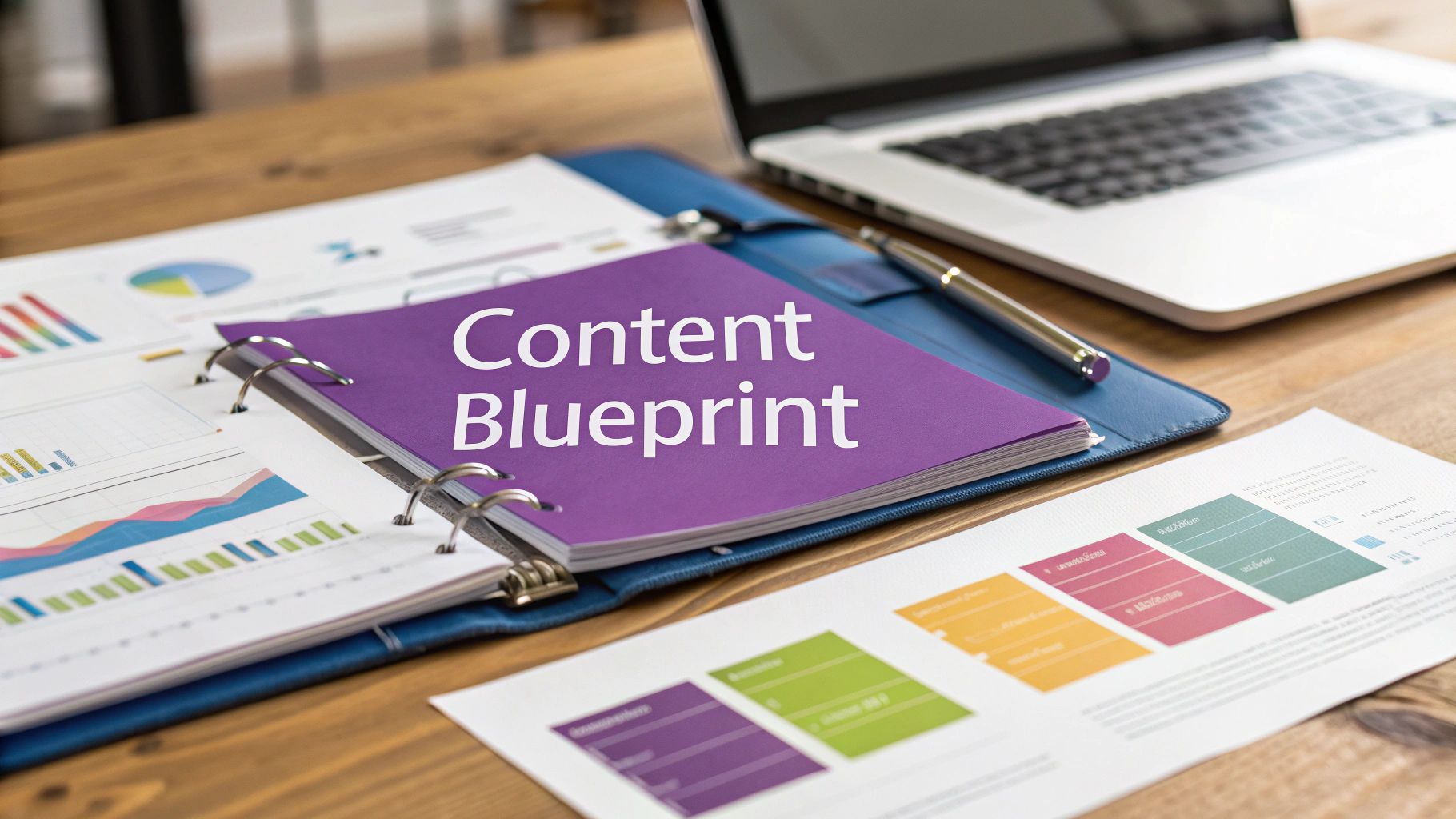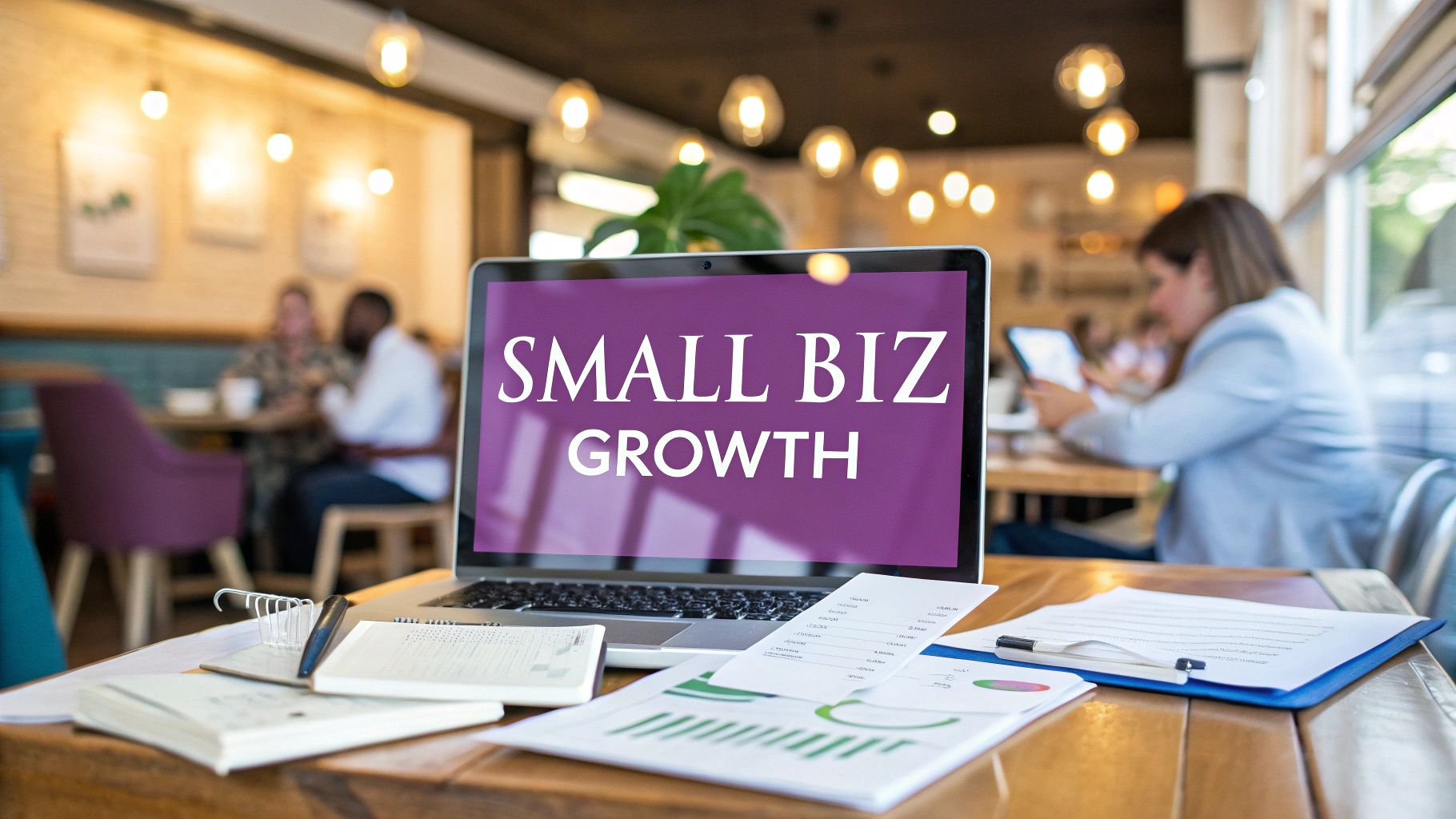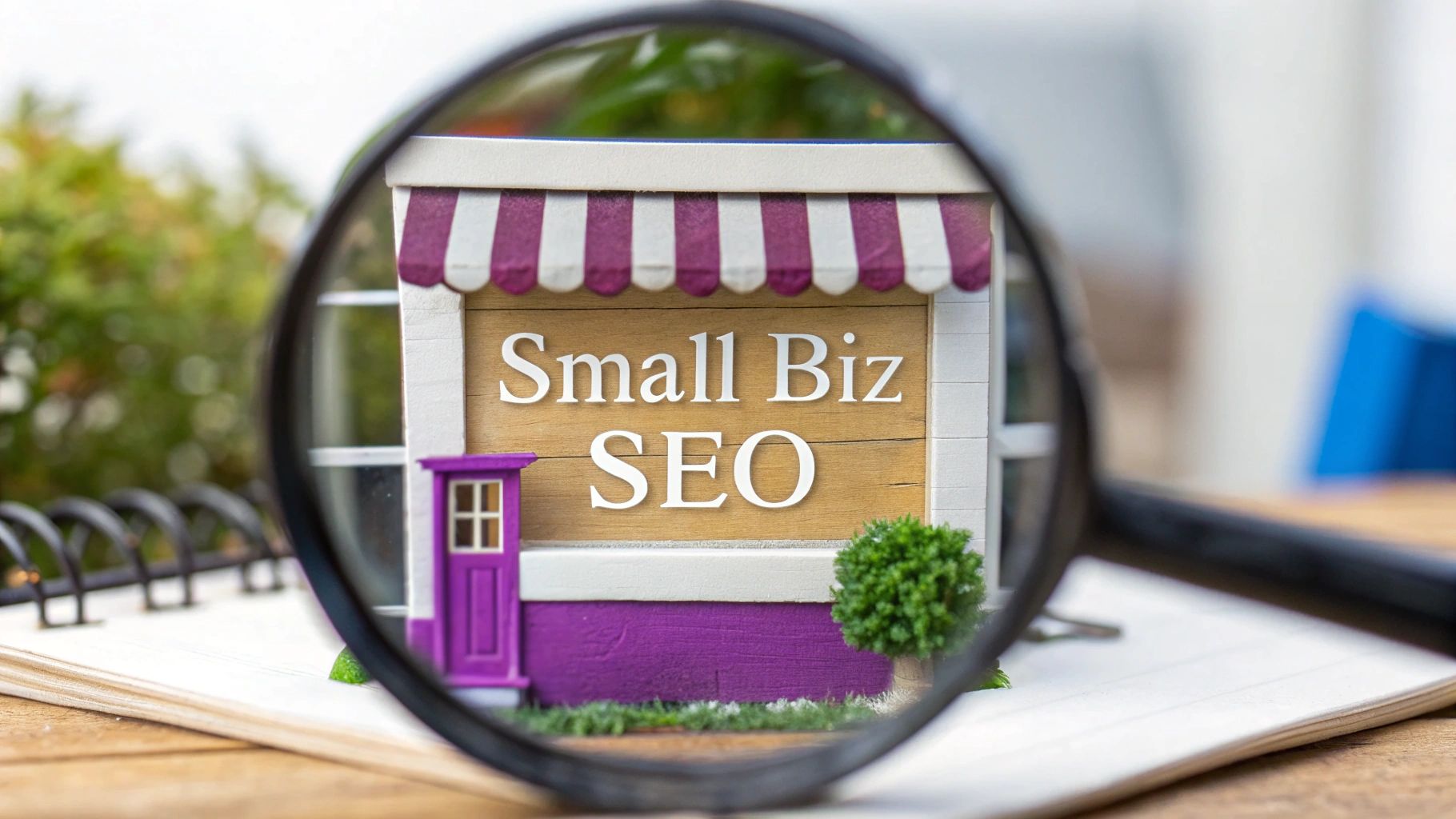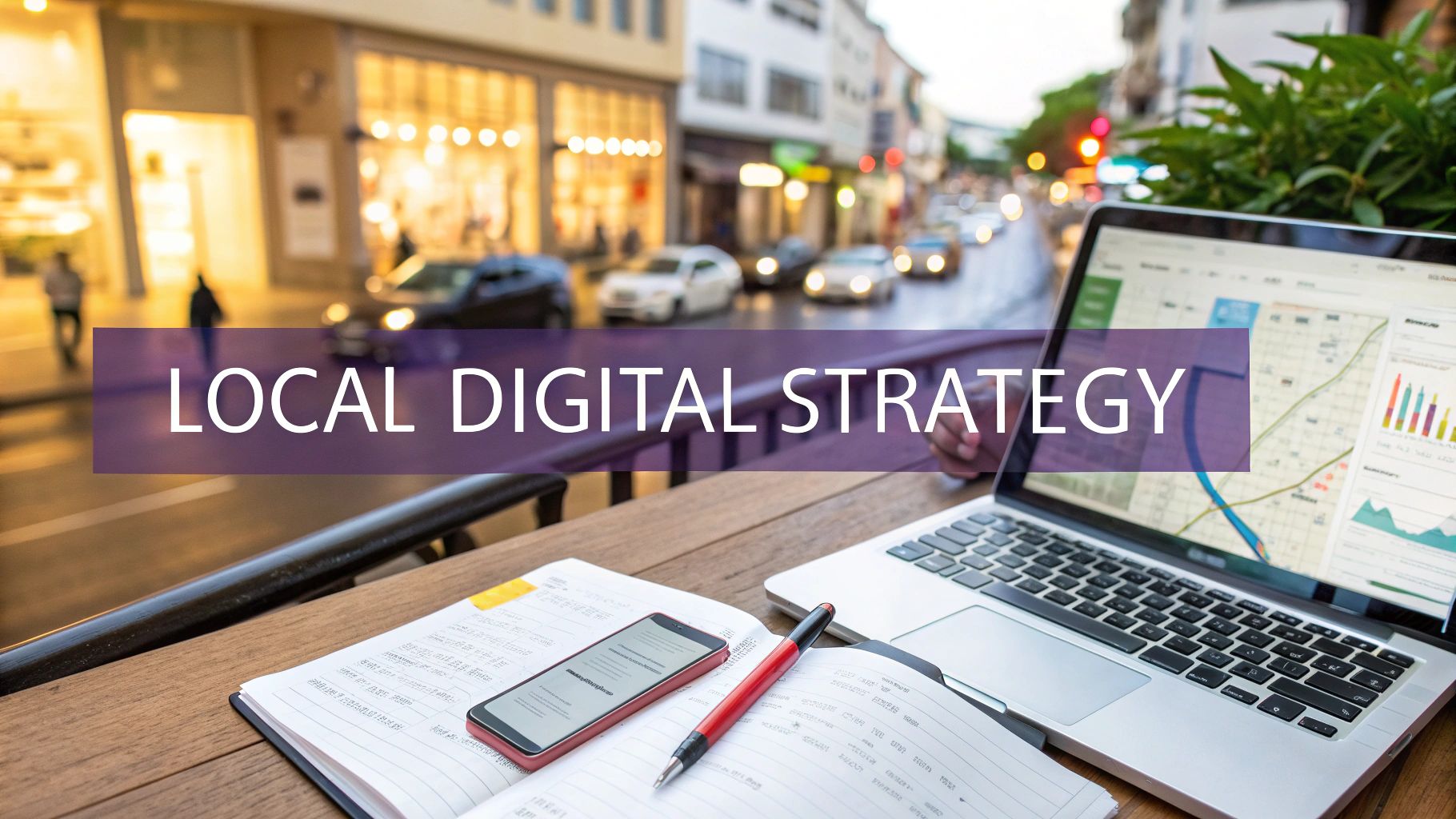Why SEO Is Your Small Business's Best Investment
Imagine hiring a sales team that works 24/7, never calls in sick, and brings in new customers even while you’re asleep. That's what effective SEO for small business can do. While competitors might pour money into ads that vanish the moment the budget runs out, you’re building an asset. Think of it as owning your spot online instead of just renting it.
Building Trust and Credibility Organically
Paid ads can sometimes feel like a pushy salesperson interrupting a good conversation. Ranking high in organic search results, on the other hand, is like getting a warm referral from a trusted friend. People naturally place more faith in organic results. When your business shows up at the top of a search page on its own merit, it sends a strong message that you’re an authority in your field. You’ve earned that spot, and potential customers take notice.
This trust leads directly to more clicks and better-quality leads. Every blog post you publish or service page you optimise acts as another pillar supporting your brand's reputation. This is how local businesses can often build a stronger community connection than larger, faceless corporations.
A Tangible Return on Your Investment
The numbers clearly show why SEO is such a smart financial decision. With organic search driving 53% of all website traffic, it has become the most important channel for online visibility. It's not just about traffic, either. A significant 70% of marketers state that SEO generates more sales than paid advertising.
This isn't a fleeting trend. Projected SEO spending in Australia is on track to hit $1.5 billion in 2025. Small businesses are a huge part of this growth, often seeing an average return on investment of around 400% within two years.
The data here shows a clear upward trend, confirming that businesses recognise its value. The question is no longer if you should invest in SEO, but how you can make it work for you.
Future-Proofing Your Business Growth
Putting resources into SEO is about creating a sustainable marketing engine. Each optimised page and quality backlink you gain is a permanent asset that keeps delivering value month after month. This creates a solid foundation that makes all your other marketing activities more effective.
As technology changes, adapting is key. The future of online success will involve incorporating smart AI Search Engine Optimization strategies to keep up with new search algorithms and user habits. By focusing on SEO for small business now, you aren’t just looking for today's customers; you’re securing your spot in the market for years to come.
Keyword Research That Actually Brings In Customers
Forget trying to rank for vague, ultra-competitive keywords like ‘best restaurant’ or ‘cheap lawyer’. The real secret to effective SEO for small business is getting inside your customers' heads to understand exactly how they search. Think of keyword research as listening in on your customer's private conversations with Google. A search for ‘emergency plumber Ryde 2am’ isn't casual browsing—it's someone with an urgent need, ready to hire on the spot. This is the kind of specific query you want to capture.
Distinguishing Browsers From Buyers
The trick is to tell the difference between searches that show simple curiosity and those that signal a strong desire to buy. These high-intent phrases, known as long-tail keywords, are typically longer and more detailed than general searches. While fewer people search for them individually, they attract visitors who are much closer to making a purchase. For example, someone searching for ‘shoes’ is probably just looking around. But a search for ‘women's size 7 black leather ankle boots Australia’ shows someone who knows precisely what they want and is ready to pull out their credit card.
The infographic below shows the difference between broad "head" keywords and specific "long-tail" keywords.
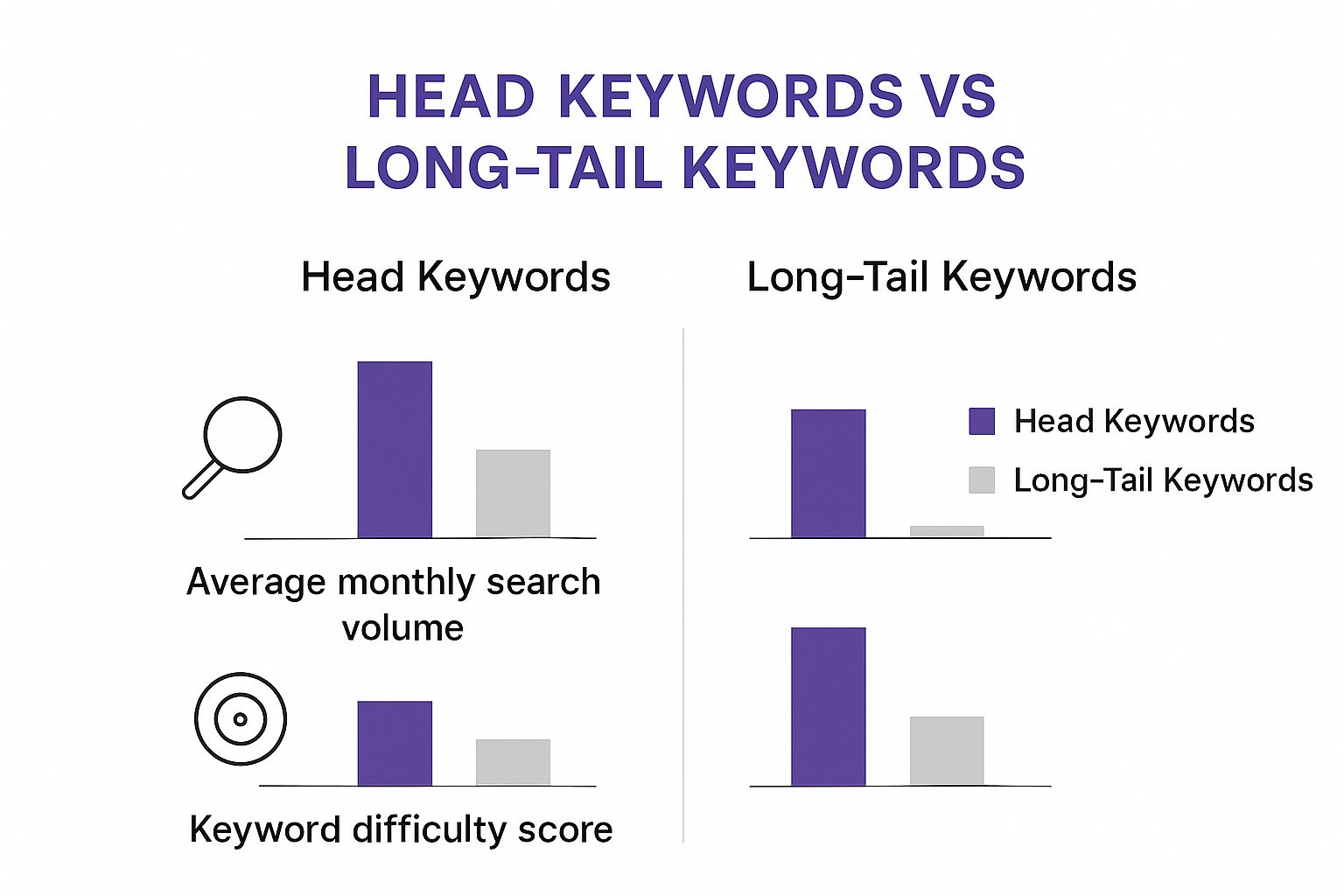
As you can see, long-tail keywords are much less competitive. This gives small businesses a genuine opportunity to rank on search engines and attract highly motivated customers. This targeted strategy is a key part of many successful marketing channels for businesses focused on real growth.
Finding Your Golden Keywords
So, how do you discover these valuable phrases? Begin by thinking from your customer's point of view.
- What specific problems does your product or service solve for them?
- What questions would they type into Google?
- What location-based words would they use (e.g., 'near me', 'in Brisbane')?
Once you have a brainstormed list, it's time to use keyword research tools to check your ideas and find new ones. While there are powerful premium tools available, many free and low-cost options provide all the data a small business needs to get started.
To help you choose the right tool for your business, here's a comparison of some popular options.
Keyword Research Tools for Small Business Success
Essential tools comparison with practical features and realistic budgets for growing businesses.
| Tool Name | Monthly Cost | Best Features | Perfect For |
|---|---|---|---|
| Semrush | Starts at $129.95 USD/month | Comprehensive suite including competitor analysis, rank tracking, and site audits. | Businesses ready to invest in an all-in-one SEO platform for deep market insights. |
| Ahrefs | Starts at $99 USD/month | Powerful backlink analysis, keyword explorer, and content gap analysis. | Small businesses focused on building a strong backlink profile and outranking competitors. |
| Ubersuggest | Starts at $29 AUD/month | User-friendly interface, great for keyword ideas, and offers a limited free version. | Beginners and small businesses looking for an affordable, easy-to-use tool to get started. |
| Google Keyword Planner | Free (with a Google Ads account) | Directly sources data from Google, excellent for finding commercial keywords. | Any business, especially those running Google Ads campaigns, to get data from the source. |
Choosing the right tool depends on your budget and goals. For many small businesses, starting with a free tool like Google Keyword Planner or the free version of Ubersuggest is a great way to learn the ropes.
By creating a keyword list that balances realistic competition with clear purchase intent, you move from guesswork to a strategy that attracts actual customers, not just website visitors. This is the foundational step in building an SEO plan that drives real business growth.
Local SEO: Becoming the Obvious Choice in Your Area
While competing with national chains can seem like an uphill battle, local SEO is the secret weapon that helps small businesses win on their home turf. Think of it as becoming the trusted, go-to expert in your neighbourhood. When someone searches for ‘cafe near me’ or ‘emergency plumber in Brisbane’, you want your business to be the obvious and most reliable choice, not just another name on a long list. This is where your deep connection to the community gives you a real edge.
Optimising Your Digital Front Door: Google Business Profile
Your Google Business Profile (GBP) is your most important local SEO tool. It’s often the very first impression a potential customer gets, showing up prominently in both Google Search and Maps. Getting it right is about more than just filling out a form; it's about giving customers the exact information they need to make a quick decision.
Here’s a glimpse of the Google Business Profile dashboard, your control panel for managing how your business appears across Google.

This dashboard is where you can update your opening hours, reply to customer reviews, and upload photos that show off what makes your business unique.
To get the most out of your GBP, concentrate on these essential elements:
- Accurate NAP: Your Name, Address, and Phone number must be 100% consistent everywhere online, from your website to other directories.
- Categories: Be as specific as possible with your primary category. If you run a cafe that’s famous for its croissants, select ‘Patisserie’ instead of the broader ‘Cafe’.
- High-Quality Photos: Regularly add clear, appealing photos of your shopfront, products, team, and services in action. This builds trust by showing customers what to expect.
- Google Posts: Use this feature to announce special offers, events, or news. It signals to Google and customers that your business is active and engaged.
These details are crucial for appearing in the Google Map Pack—that highly visible box of three local businesses featured at the top of search results for local queries. For more detailed strategies, you can explore our complete guide to ranking in the Google Map Pack.
Building Trust Through Reviews and Local Signals
Reviews are the modern version of word-of-mouth recommendations, and they hold significant weight with both customers and search engines. Encouraging genuine feedback is a key part of SEO for small business. Make it simple for happy customers to leave a review by sending a follow-up email or adding a link on your receipts. Always respond to all reviews—good and bad—to show you care about the customer experience.
The power of this local focus is undeniable. In Australia, the link between online searches and offline purchases is incredibly tight. A huge 78% of local searches on mobile devices result in an offline purchase within 24 hours. And with 46% of all Google searches having local intent, being visible in your area isn’t just a nice-to-have; it's fundamental to your growth. To really capture the local market, check out these 10 Local SEO Optimization Tips for practical advice. By focusing on your local community, you can build a strong defence around your business that larger competitors will struggle to penetrate.
On-Page SEO: Making Every Page Work Harder for You
If your website is your digital shopfront, then on-page SEO is how you organise your products and services on the shelves. It’s the practice of arranging every part of a webpage—from the text and titles to the images—to clearly signal what that page is all about to both potential customers and search engines. This isn't about complicated code; it's about making smart, deliberate improvements so each page contributes effectively to your business goals.
Think of it this way: when a customer walks into a physical store, they rely on aisle signs and product labels to find what they need. On your website, those signs are your headings, page titles, and even the descriptions of your images. Getting these right is fundamental to making your website easy to navigate and understand.
The Most Important On-Page Signals
While there are countless on-page factors, small businesses can see significant gains by focusing on a few high-impact areas. These are the core elements search engines like Google examine first to understand your content and determine its relevance to a searcher's query.
Many of these elements can be easily edited within your website's content management system, like WordPress. You don't need to be a web developer to make these crucial updates.
As you can see, the interface makes these settings accessible, giving you direct control over how your pages appear in search results.
Here’s a breakdown of the essentials:
-
Title Tags: This is the main headline that appears in Google search results and at the top of a browser tab. It’s your single best chance to capture someone's attention. A powerful title tag is descriptive, contains your main keyword, and makes a clear promise to the reader. For example, "Services" is weak, but "Expert Electrical Services for Brisbane Homes | Call Us" is strong and specific.
-
Meta Descriptions: This is the short summary that appears below your title tag in search results. While not a direct ranking factor, a compelling meta description acts like ad copy, persuading users to click your link instead of a competitor's. It should summarise the page's value and ideally include a call to action.
-
Headings (H1, H2, H3): Headings give your content structure and improve readability. The main title of your page should always be wrapped in an H1 tag and include your primary keyword. Use H2 and H3 tags for subheadings to break up long blocks of text and guide readers through the information. This creates a logical flow that both users and search engines can easily follow.
-
Image Alt Text: This is a brief, written description of an image on your site. It serves two key purposes: it helps visually impaired users understand the image's context through screen readers, and it gives search engines another clue about your page's topic. Instead of a generic filename like
IMG_1234.jpg, use descriptive alt text likeprofessional-plumber-fixing-a-leaky-kitchen-tap.
To help you prioritise, here is a simple matrix outlining where to focus your efforts for the best results.
| On-Page SEO Priority Matrix for Small Businesses |
|---|
| Essential optimization tasks ranked by impact and effort required for maximum efficiency |
| Optimization Task | Business Impact | Effort Required | Timeline |
|---|---|---|---|
| Title Tag Optimisation | High | Low | Immediate (1-4 weeks to see results) |
| Meta Description Writing | High | Low | Immediate (1-4 weeks to see results) |
| H1 & Heading Structure | High | Low-Medium | Immediate (2-6 weeks to see results) |
| Internal Linking | High | Medium | Ongoing (builds value over time) |
| Image Alt Text | Medium | Low | Immediate (can be done incrementally) |
| Content Quality & Keyword Use | High | High | Ongoing (long-term strategy) |
This table shows that optimising titles, descriptions, and headings offers the biggest return for the least amount of effort, making them the perfect place for any small business to start.
The Power of Internal Linking
Beyond optimising individual page elements, internal linking—the practice of linking from one page on your website to another—is a simple but incredibly effective tactic. When you add a link to another relevant page on your site, you create a helpful pathway for both users and search engine crawlers.
This practice helps spread "link authority" throughout your website, signalling to Google which pages are most important. It also guides visitors to other useful content, keeping them on your site longer and moving them closer to becoming a customer. For example, a blog post on "5 Signs You Need a New Roof" should always contain a link to your "Roof Replacement Services" page. These connections build a stronger, more useful website.
Content That Converts Browsers Into Buyers
Getting your business to the top of search engine results is a major win, but it's only the first step. The real prize is turning those visitors into paying customers. This is where your content plays a crucial role. Instead of thinking of it as a sales pitch, view your content as a helpful conversation. It’s your opportunity to answer your audience's questions, address their worries, and build the trust that guides them from simply browsing to actually buying. For a small business, effective SEO means creating content that sells by serving.
Writing for People, Not Just Algorithms
The most effective content is genuinely helpful, not just a thinly veiled advertisement. It all starts with understanding the real questions your potential customers are asking, beyond the basic keywords you want to rank for. When you tackle their specific problems with practical advice, you position your business as a credible and valuable resource.
Imagine a landscaping company in Brisbane. Instead of a generic "Landscaping Services in Brisbane" page, they could write a blog post titled, "5 Common Lawn Pests in Brisbane and How to Deal with Them". This approach not only builds trust but also attracts people who are actively looking for solutions.
Your service pages are a perfect place to apply this thinking. Don't just list what you do; tell a story. Share case studies or walk through past projects to show your expertise in action. This narrative style lets you naturally include important keywords while showing potential clients how you solve problems just like theirs.
You can easily manage this kind of content using a platform like WordPress. Its clean interface makes it simple to create blog posts and service pages that speak directly to customer needs.
A straightforward editor helps you craft content that answers questions and turns casual interest into concrete leads.
Maximising Your Content's Value
Creating great content takes time and effort, so you need to make every piece count. A single, detailed blog post can be broken down and reused in many ways. For instance, you could:
- Turn key points into eye-catching graphics for social media.
- Expand on a specific section in an email newsletter.
- Summarise the main ideas in a short, engaging video.
This strategy of repurposing content extends its lifespan and gets your message in front of more people across different platforms, all without having to start from scratch each time.
Beyond text, video is a powerful tool for building a personal connection with your audience. To learn more about how you can use it effectively, explore some small business video marketing strategies.
Ultimately, content that converts does two jobs at once. It ticks the boxes for search engines by being relevant and high-quality, and it satisfies the human desire for reliable information. By focusing on creating genuinely useful guides, articles, and service descriptions, you build a powerful business asset. This is a vital part of any strong digital marketing strategy, transforming your website into a 24/7 sales tool that fosters lasting customer relationships.
Technical SEO Made Simple for Small Business Owners
Technical SEO can sound like a complex job best left to web developers, but the basics are something any small business owner can grasp. Think of it like maintaining your car—you don't need to be a mechanic to check the oil or tyre pressure, but these simple checks keep your vehicle running smoothly. The same principle applies to your website; a few key adjustments can significantly improve its performance.
Site Speed and Mobile Friendliness: The Non-Negotiables
Two of the most important parts of technical SEO are site speed and mobile-friendliness. With most of your customers searching from their phones, a slow or clunky mobile site can be a deal-breaker. A delay of just a few seconds is often enough for a potential customer to give up and head to a competitor's site. A slow website not only frustrates users but also hurts your search rankings, as Google gives preference to sites that offer a fast, seamless experience.
Likewise, your website must be responsive, which means it automatically adjusts to look great and work perfectly on any screen, from a large desktop monitor to a small smartphone. This isn't just a "nice-to-have" feature; it's essential for business. A site that is difficult to use on a phone will drive customers away.
Your Technical SEO Toolkit
You don't need a suite of expensive tools to monitor your website's technical health. Google Search Console is a free and powerful resource that acts as a direct communication channel between your website and Google. It helps you track your site's performance, submit sitemaps, and find technical issues before they grow into bigger problems.
Here’s a glimpse of the Google Search Console dashboard, where you can see an overview of your site's performance and health.
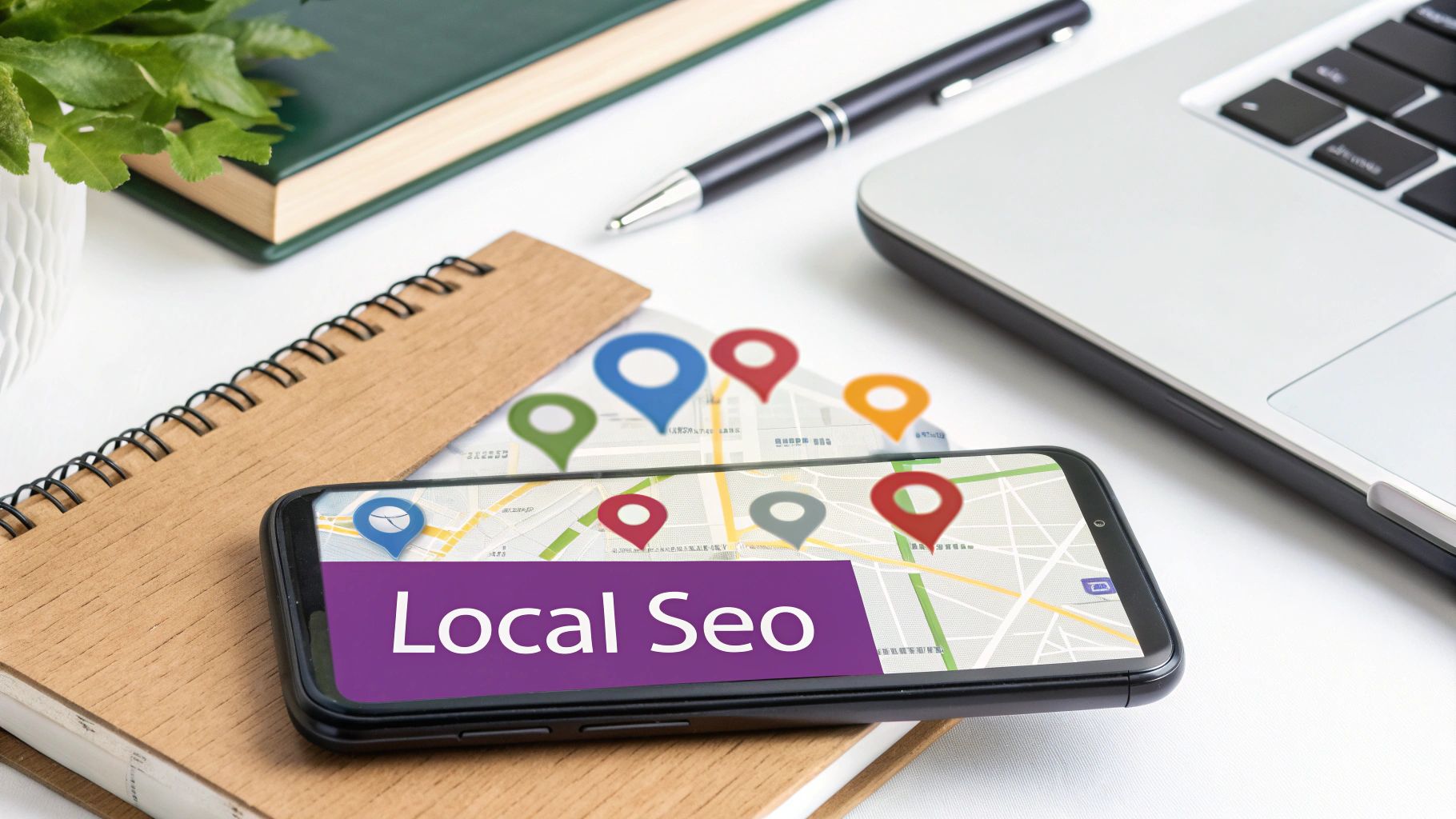
This dashboard offers vital data, pointing out indexing problems or manual actions that could be affecting your visibility in search results.
A few other key technical elements include:
- XML Sitemap: This is a file that lists all the important pages on your website, making it easier for search engines to find and crawl your content. Most modern website builders create and update this for you automatically.
- SSL Certificate: This ensures your website has a secure, encrypted connection (you'll see "https://" in the URL). It's a standard for building trust and a confirmed ranking factor.
- Clean URL Structure: Keep your page URLs short, logical, and easy to read. For instance,
yourwebsite.com.au/contactis much better thanyourwebsite.com.au/page-id-123.
By focusing on these core components, you’re not just trying to please search engines; you’re building a better, faster, and more dependable website for your customers. This foundational work supports all your other SEO for small business efforts, making sure your great content has a solid technical base to build on.
Building Authority Through Authentic Relationships

Tools like Ahrefs track the number and quality of backlinks pointing to your website. This dashboard shows how a site’s authority grows over time through consistent, high-quality links from reputable domains—a vital part of successful SEO for small businesses.
For a small business, the best way to build this authority is through genuine relationships, not expensive shortcuts. Think of link building less as a technical chore and more as community networking. It's about connecting with other local businesses and groups that share your values and serve a similar audience. These authentic connections are what create powerful, high-quality backlinks that last.
Earning Links Through Value and Connection
Instead of asking, "How can I get links?", reframe your thinking to, "How can I be so valuable that people want to link to me?". This mindset shift is the key to effective and ethical link building. The goal is to establish your business as a trusted voice in your field, which you can achieve by creating genuinely helpful resources and strengthening your local ties. When you consistently offer value, other websites will naturally want to reference your content as a credible source.
Start by looking for opportunities within your existing network and local community. These connections are often the easiest to make and lead to the most relevant links.
- Local Community Groups: Consider sponsoring a local sports team or charity event. These organisations are usually happy to link back to their sponsors' websites. This not only earns you a valuable local link but also boosts your community presence.
- Industry Associations: Are you a member of a local chamber of commerce or a professional body? Being listed in their directories is highly trusted by search engines and sends a strong signal about your business's legitimacy.
- Suppliers and Partners: Think about the other businesses you work with every day. Your suppliers, distributors, and other partners have a reason to want you to succeed. A simple testimonial on their website can often earn you a link back to yours.
Creating Link-Worthy Content
Another powerful strategy is to create content that other businesses and publications want to share. This is where your expertise as a small business owner can really shine. By producing valuable, relevant content, you create an asset that earns links on its own merit.
For example, a local accounting firm could create a detailed guide on "Tax Deductions for Australian Sole Traders". This type of resource is incredibly useful and is likely to be linked to by business blogs, financial advisors, and industry forums. This process of creating helpful content establishes your authority and attracts the kind of high-quality backlinks that search engines favour, driving long-term growth for your business.
Measuring Success and Scaling Your SEO Investment
Putting your time and money into SEO without keeping score is a bit like driving with your eyes closed. You need to know what's actually working to make sure your effort is worthwhile, especially when every dollar matters. Effective SEO for small business isn't about chasing impressive but empty numbers like website visits; it's about tracking results that directly affect your business, like phone calls, quote requests, and sales.
From Vanity Metrics to Valuable Insights
It's easy to get caught up in big numbers that sound good on paper, but the real test is whether your SEO is bringing in actual business. The key is to look past the surface-level data and focus on Key Performance Indicators (KPIs) that show real growth. Instead of just glancing at your overall traffic, start asking better questions:
- How many new leads did we get from organic search this month? This could be the number of people who filled out your contact form or requested a quote.
- What is our conversion rate for organic visitors? What percentage of people coming from search engines take a meaningful action on your site?
- Which pages are bringing in the most valuable traffic? Knowing this helps you create more content that resonates with potential customers.
- How are we ranking for keywords that show a customer is ready to buy? Tracking your position for high-intent terms is essential.
Tools like Google Analytics are crucial for gathering this information. You can set up specific goals to track every time a visitor completes an important action, giving you a clear picture of what’s generating real value for your business.
For instance, a Google Analytics dashboard can show you exactly where your website users are coming from.
This report clearly separates organic search traffic from other sources, letting you measure the direct impact of your SEO work.
Setting Realistic Timelines and Scaling Your Efforts
SEO is a marathon, not a sprint. It's a long-term strategy. Typically, you can expect to see significant results from a well-planned campaign within four to twelve months. This is because it takes time for search engines to find, understand, and trust your new and improved content. In these early months, focus on consistent progress rather than overnight success. Simple monthly reports tracking your KPIs are a great way to stay on track and maintain momentum.
As your business grows and you see more revenue from your efforts, you can start to scale your SEO investment. This doesn't mean you have to start over. Instead, you build on the solid foundation you've already laid. This might involve:
- Targeting more competitive keywords.
- Creating more ambitious content, like video tutorials or detailed case studies.
- Looking into advanced technical optimisations for your website.
By reinvesting the returns from your initial success, you create a powerful cycle of growth. This measured, step-by-step approach ensures your SEO strategy grows with your business, turning your hard work into long-term, sustainable success.
Ready to see how a strategic SEO plan can transform your business? CAYD Marketing builds data-driven campaigns that deliver tangible results. Contact us to find out how we can help you grow.
Article created using Outrank


